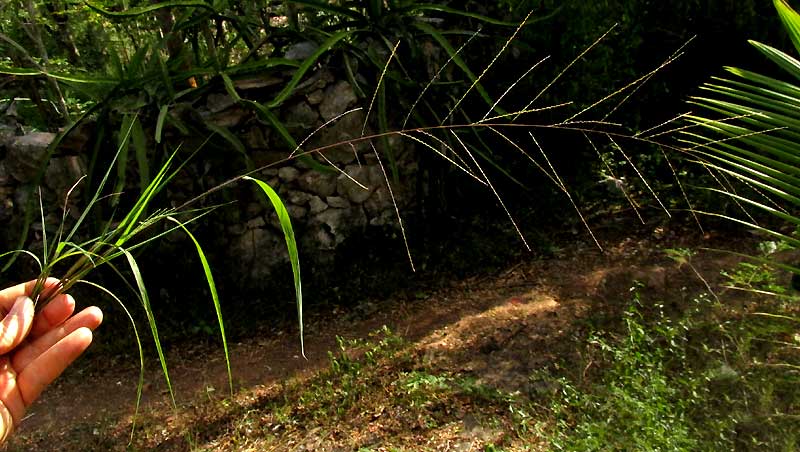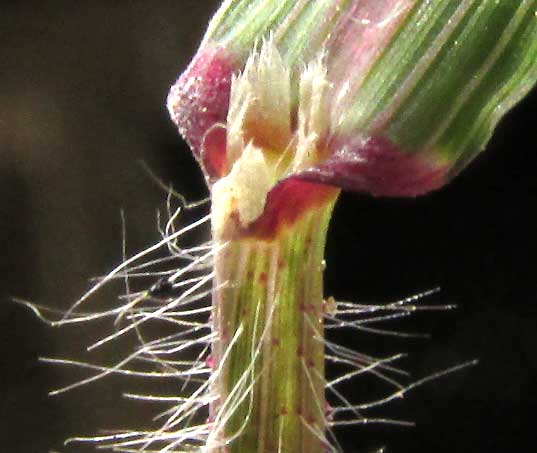Excerpts from Jim Conrad's
Naturalist Newsletter
from the March 22, 2019 Newsletter issued from Rancho Regensis north of Valladolid, Yucatán, MÉXICO;
elevation ~40m (~130 ft), N~20.876°, W~88.170°
SPRANGLETOP GRASS
In the garden, growing amid my lush bed of daily-watered mustard greens, a distinctive grass was flowering. Below, you can see its many tiny flowers, or spikelets, arrayed in a large, diffuse panicle:

Arrayed along the panicle's terminal segments, the spikelets were unusually small, the less mature ones only about 2mm long, as shown below:

More mature spikelets were a little longer, and with them it was more obvious that each spikelet contained two or more florets, as a picture below, of two spikelets, each with two florets, shows:

These features and some others led me to the genus Leptochloa, but to figure out which species of Leptochloa it was, I had to see what's on display below:

The upward pointing, white, papery, jagged-topped item at the top is the ligule, just like Leptochloa is supposed to have, but of the several Leptochloa species listed for the Yucatan, only one bears leaves whose sheathes produce such long, white hairs as this one, and that's LEPTOCHLOA PANICEA. Leptochloa panicea occurs in the tropics, subtropics and warm-temperate zones nearly worldwide. With such a great distribution area, this is a very variable, or "polymorphic," species. Currently three subspecies are recognized, ours being ssp. mucronata.
Up in Texas we've met another Leptochloa species, Leptochloa dubia, which you might enjoy comparing with the present one, because of the "variation on a theme" thing. Our Texas Leptochloa resides at www.backyardnature.net/n/h/sprangle.htm
Up there we learned to use the English name "sprangletop" for members of the genus Leptochloa, "sprangle" meaning -- at least in parts of the US -- spread-out, like our grass's flowers. Our current Leptochloa panicea doesn't seem to have a good English name, but I find some authors referring to it as Sprangletop, so that's how I think of it.
In the Yucatan Leptochloa panicea is described as flowering and fruiting during the rainy season from June to September. Our flowering plant can be excused from the rule because my wonderful mustard greens get watered every day, creating a rainy-season microclimate.
This is the first time I've noticed Leptochloa panicea and I don't believe it's very common here. Maybe it got planted in the garden when I sowed my mustard greens. The species isn't particularly favored as a pasture grass. Mainly people just think of it as a weed, despite its handsome panicle of widely dispersed, tiny flowers, and the pleasure small seed-eating animals must have feeding on its plentiful tiny seeds.